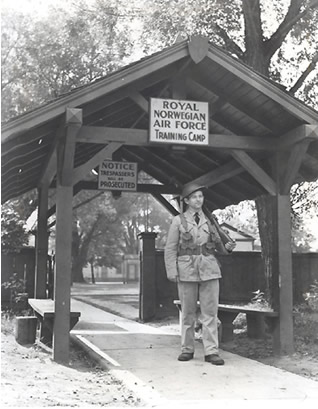



In May 1940 General Ruge ordered Capt. Bjarne Øen who was then head of the Army Air Force, to take as many Air Force personnel as possible to England. This order was repeated from London when the first radio contacts with Norway were established.
Ideally the Norwegian authorities wished to form a Norwegian Air Force training base in Europe but this was not possible in England. After the fall of France, the only other viable alternative was Canada. In July 1940 Major Bjarne Øen and Captain Hjalmar Riiser-Larsen were appointed respectively heads of the Army and Naval Air Forces in Canada.
The Toronto Flying Club turned over its airport and training aircraft to the Norwegian authorities on Sept 7, 1940. Eleven experienced pilots from Norway participated in the first training course.
On July 21, 120 officers and men sailed to Canada on the Norwegian coastal vessels “Iris” and “Lyra”. Negotiations with the Canadian Government resulted in an agreement that on September 7 1940 the Toronto Flying Club turned over its airport and training aircraft to the Norwegian authorities.
 Situated next to the Toronto Maple Leaf’s baseball stadium, the airport was separated from Toronto by a narrow strip of water and on November 10 the camp, known as “Little Norway” was opened in the presence of Canadian and Norwegian leaders and aviation pioneers.
Situated next to the Toronto Maple Leaf’s baseball stadium, the airport was separated from Toronto by a narrow strip of water and on November 10 the camp, known as “Little Norway” was opened in the presence of Canadian and Norwegian leaders and aviation pioneers.
Eleven experienced pilots from Norway participated in the first training course.
Training was initially conducted using combat planes, some 20 million dollars worth, purchased from the United States before the war. They did not reach Norway in time to be used in the first months of the war. Instead, they were delivered to Little Norway. They comprised Fairchild PT-19 elementary trainers, Curtiss fighters, Douglas attack bombers, and Northrop patrol seaplanes. They were later joined by Harvard trainers purchased with some of the 400,000 dollars received under the “Wings for Norway” fundraising campaign which received contributions from various Nordic associations, including some 100,000 dollars from Swedish-Americans, Norwegian expatriates, Canadians and Americans.
In 1942 a second training centre was established at Muskoka Airport, 120 miles north of Toronto and when the Royal Canadian Air Force purchased the Toronto training centre, “Little Norway” was transferred to Muskoka.
The men trained at Little Norway served in three Norwegian squadrons: 330, 331, and 332. Squadron 330 arrived in Iceland in April 1941. With single motor Northrops they patrolled the North Atlantic on the look-out for enemy submarines. Later the squadron moved to the Shetlands with their newly acquired Sunderland flying boats.
Squadron 331, the first all Norwegian fighter squadron with complete air and ground crew, arrived in Catterick, England, in June 1941 and squadron 332 followed in January 1942.
Both squadrons became part of 132 Wing RAF and in addition to the routine search and destroy sorties, they participated in the Dieppe Raid, the Normandy landings and the liberation of Holland.
On September 25, 2007 the Prime Minister of Norway officially opened the Little Norway Memorial in Muskoka. It was a big day for the 50 invited Norwegian Little Norway veterans. Prime Minister Jens Stoltenberg thanked the Canadians for all they had done for the 3,300 young Norwegians who came to Canada to continue their resistance against the German invaders.
In the book “The Spirit of Little Norway” by Edvard Omholt-Jensen there is a list of 3593 names of those who served at “Little Norway”.
Sources: Leon Luckow
http://www.emb-norway.ca/norwaycanada/littlenorway/
http://public.fotki.com/Profero/reunion/canada-re-ln-let/littlenorway-rnaf/
http://en.wikipedia.org/wiki/Little_Norway/